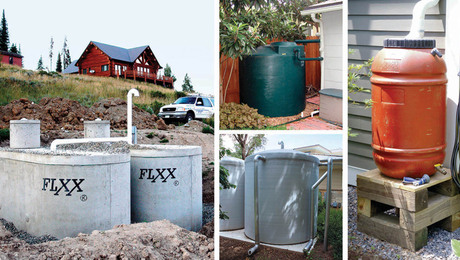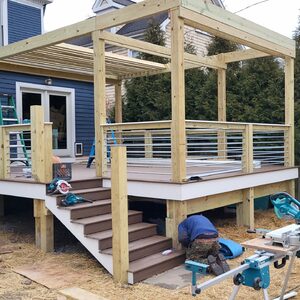I’m in the planning stages of an attic build-out at my house. The existing floor joists in the attic (ceiling joists for my 1st floor) are 2×6’s and will need to be sistered to at least 2×10’s to handle the new loads of the build-out for the span that they cover. That part is simple enought, but I may be able to save a pile of money by using 14″ tall LVL I-beams that have been offered to me by my lumber supplier at an extremely reduced rate. My question is what is the best way to secure the I-beams to the 2×6’s when I sister them? Normally I would glue/screw the 2×10’s to the 2×6’s but this is not so easy with the cross-section of an I-beam. Do I need to install some sort of blocking between the 2×6’s and the I-beams? I don’t want to create a bunch of additional work for myself or have extra costs that may make the I-beams an inferior choice to the 2×10’s.
Discussion Forum
Discussion Forum
Up Next
Video Shorts
Featured Story

There's a constant source of clean water for you to use, and all you have to do is collect it.
Highlights
"I have learned so much thanks to the searchable articles on the FHB website. I can confidently say that I expect to be a life-long subscriber." - M.K.

















Replies
Fill the web of the I joist with ply on one side and go from there.
Ouch, that sounds like a lot of extra work and material. I will have approximately 1,200 LF of I-beams, and with 10"-11" of plywood strips on one side of the web, that roughs out to be about 32 sheets of plywood.
I know that's one way to do it , but what other options do I have? Has anyone done this exact scenario before?
You only need plywood to cover the 2x6 less the width of the bottom of the I joist so say 4 inches. any plywood above the 2x6 would serve no purpose except to perhaps make the I joists even stiffer.
Do they even need to be sistered? You don't need to beef up the 2x6's. They are doing their job fine now and the I joists at that depth should be more than enough to do their new job which is support themselves and the floor you are going to put on top assuming they are supported correctly from below.
Good point about the actual "need" to be sistered. Other than avoiding some existing can lights, there is no reason why they couldn't sit anywhere in between the existing 2x6 joist cavity.
sistering joist
First. Why is it necessary to structurally sister the TJI's to the existiong 2 x 6 joist? My GUESS is that the lumber yard did not do the calculations for the TJI's using the existing joist as part of their calculations. Fastening the two together as a single structural unit gets pretty techy.
The lumber yard should have the required details for modifying the TJI's where they will bear on the walls at the eaves and bearing points.
Check with them too see what their thinking was.
sistering joist
You might check the Oct. 2011 issue of the Journal of Light Construction magizine, page 25. It is a pretty envolved method, but might be worth a look.
Ask the manufacturer
I'd call or email the engineers at the truss manufacturer and ask them.
Fastening into the center plate may not be allowed. The manufacturer's engineers will know what you can and can't do, and are familiar enough with their product to make valid recommendations.
Yeah, if the I-beams are big enough to carry the load (which would depend on the beam specs, the span distance, and the code load-bearing requirements) then there's no need to sister them. (And I'm guessing that 14" tall I-beams can easily carry the load.)
What IS needed, however, is for them to bear on the plates at either end, and that would likely be the "gotcha". When you sister you can actually stop a few inches short at each end, allowing the sisters to be short enough to be worked into place. But without sistering the ends need to have full bearing. Worst case you might have to knock holes in the roof. (There's also the issue of interference with the roof. You might have to dog the corners of the beams, and that would need to be cleared with the beam manufacturer.)
If you do use the I-beams without sistering, you need to remember to somehow prop them up slightly at the ends (eg, pieces of plywood under the ends), so the beams don't bear on the ceiling.
Thanks Dan
After some weekend research I think I'm just going to use the 2x10's and sister them to the original 2x6's. As for the bearing issue on the existing ceiling, it is plaster on wood lathe so I will definitely need to lay a 2x on top of the existing plate and let the 2x10's bear on it instead so I won't crack my plaster ceilings.
Span deflection
If your going with the 2x10's you only need to raise them off the plate 3/4 -1" ( 1-2 pcs. of plywood).
Fasten the 2x6 to the 2x10 only where they cross over the plates, not in the mid-span, also calc. the deflection on the 2x10' s at a lesser allowance (L / 720 vs. L / 360 for the 2x6's) if you want to fasten them mid-span.
Good Luck
Geoff
Thanks Dan
After some weekend research I think I'm just going to use the 2x10's and sister them to the original 2x6's. As for the bearing issue on the existing ceiling, it is plaster on wood lathe so I will definitely need to lay a 2x on top of the existing plate and let the 2x10's bear on it instead so I won't crack my plaster ceilings.
Nothing in your existing ceiling will be straight so it's a good call to avoid sistering if at all possible unless you want to straighten the ceiling out, it will also lessen noise transmission between floors if the exsisting ceiling joists and new floor joists are not in contact.
You'll find the ceiling is probably sagged quite a bit mid span and your new 2x10s won't come near to touching mid span so a full 2x seems to be a bit much to bring the new floor joists off the plates - I'd probably use 3/4 ply as a spacer for a client's house. If it were my house I'd sister to the ceiling just to keep the ceiling flat even if it ment fixing a few new cracks caused by bringing it up mid span. In that case you'd want to get all your new floor joists in possition and as evenly as possible pull the ceiling joists up a little at a time. I'd still use 3/4 ply as a spacer on the plates to avoid having to chisel the plaster squeeze out directly under the floor joists. There are long screws with wide heads made for landscaping timbers that would work well in conjunction with some 2x's perpendicular to your joists to bite into the old joists and provide all the pull needed to bring them up. Another option would be timberlocks with a flat washer under the head of the screw.
Second story additions are always interesting...watch that things are level - often in old houses they aren't and you'll have to decide if you want to fix the first floor so the whole house sits level (often not that difficult) or if you are going to shim up the second floor so it's flat. I once had a house that we were putting a second story addition onto and it already had a section of the house rebuilt without fixing how level the first floor was - we couldn't corectly fix the house without screwing up the other new improvements that were made previously. If the previous remodeler had fixed the house properly to begin with (at a cost of only a few thousand) the result of that $300k project I was in control of would have been much better.
Good building!